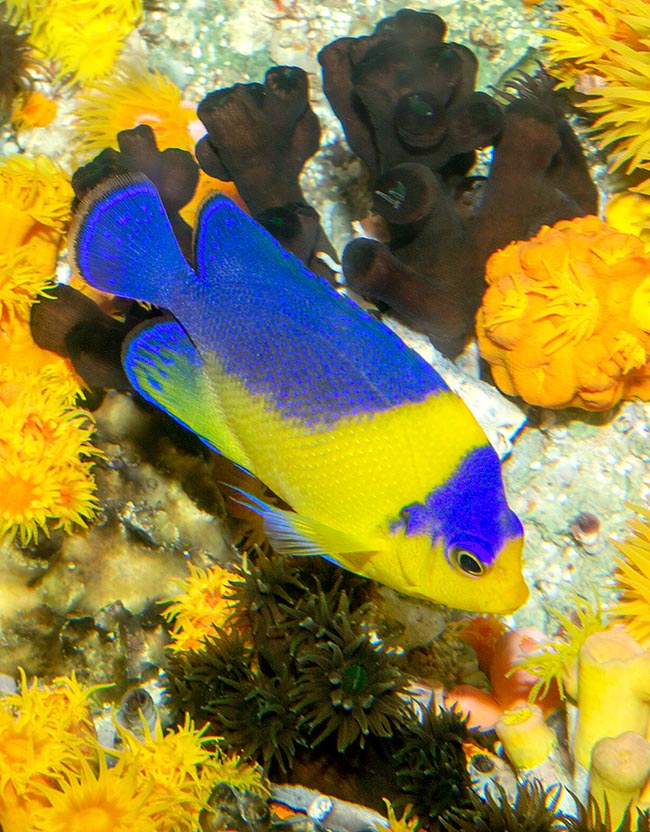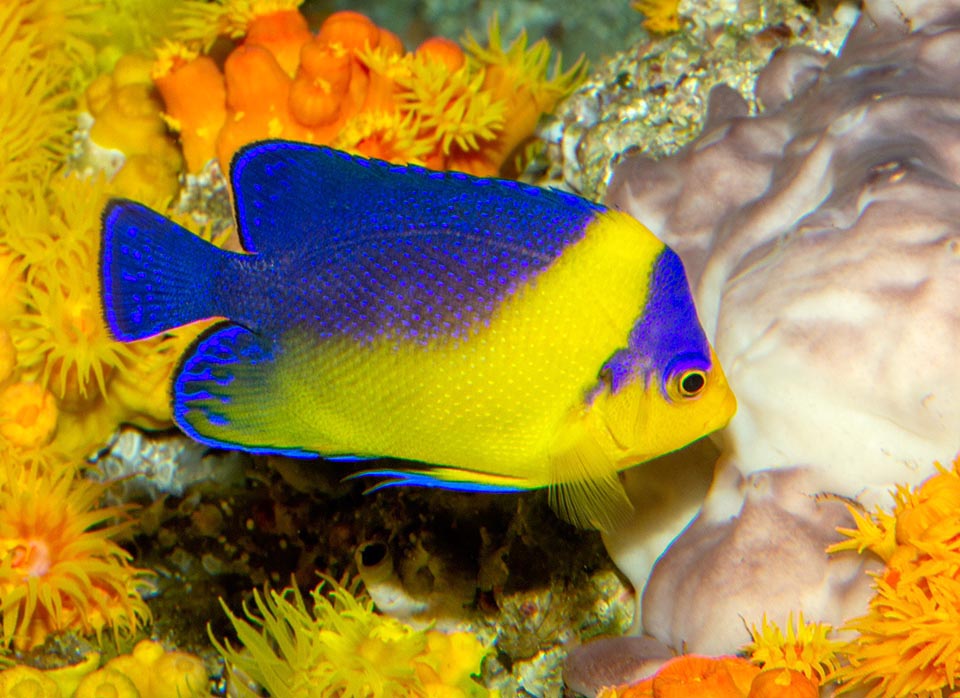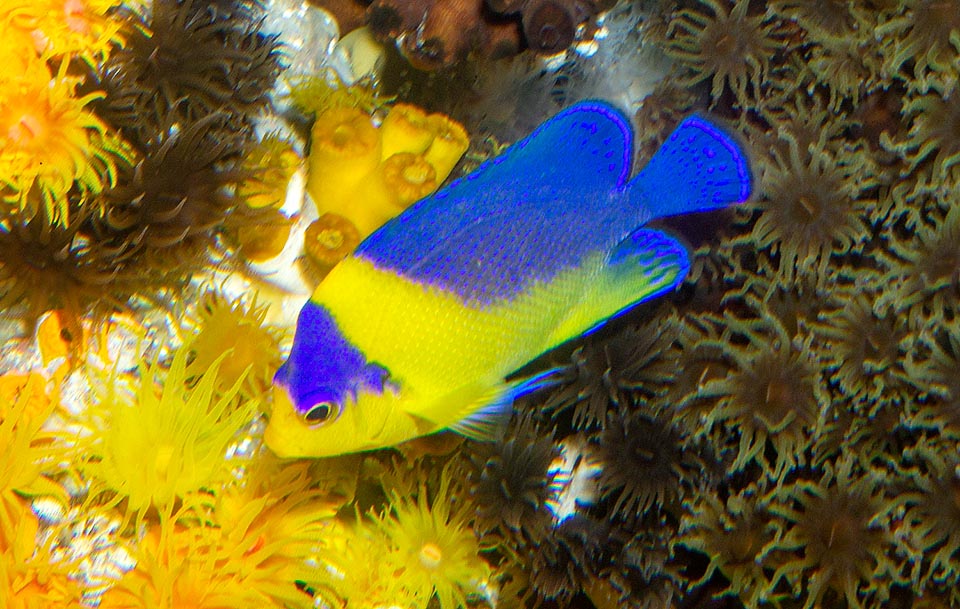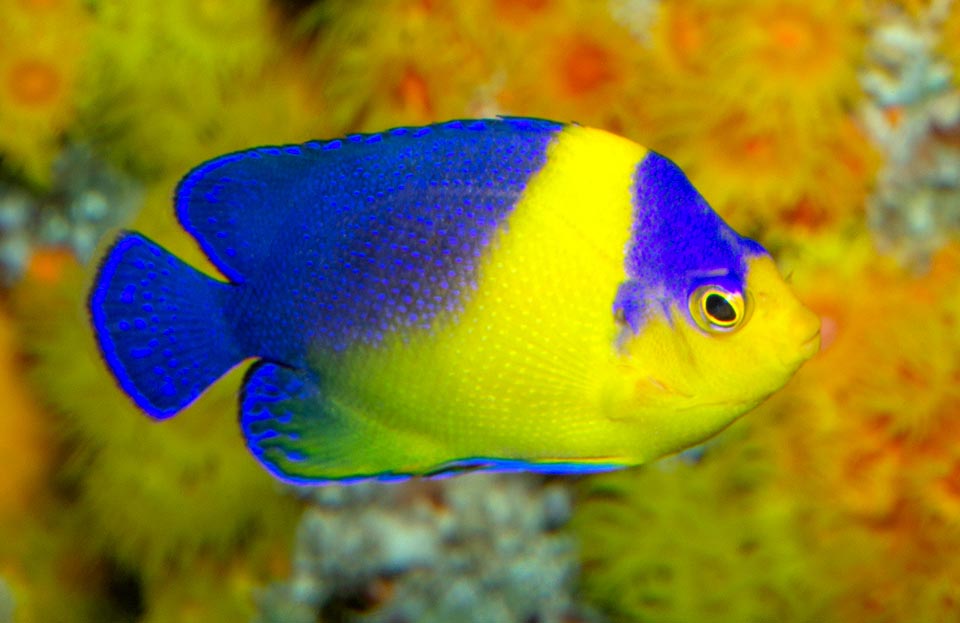Family : Pomacanthidae

Text © Giuseppe Mazza

English translation by Mario Beltramini

Described only in 1969, Centropyge venusta is a species with relatively modest area in West Pacific © G. Mazza
Centropyge venusta (Yasuda & Tominaga, 1969), known in various languages as Blue-backed angelfish or Purple Mask angelfish, belongs to the class of the Actinopterygii, the ray-finned fishes, to the order of the Perciformes, and to the family of the Pomacanthidae, rightly the one of the Angelfishes, that, counts 8 genera and almost one hundred coloured species.
Fishes that at times may even exceed the 40 cm, like the majestic Pomacanthus maculosus or the Pomacanthus annularis, frequent guests of the public aquaria, such as the Pomacanthus paru, the Holacanthus ciliaris, or the Holacanthus bermudensis, but also small fishes like those belonging to the genus Centropyge, the most numerous of the family that nowadays counts, in 2020, more than 30 species.
The Pomacanthidae gather marine tropical fishes of rather shallow waters, characterized by a body strongly compressed on the sides and an eye-catching defensive spine at the base of the preoperculum.
There are of course no exceptions for the genus Centropyge, which derives from the Greek “kέντρον” (kentron) = sting, and “πυγή” (pyg) = back, with reference to this spine facing the tail.
The specific term venusta comes from the Lain “venustus” = full of carm, perfect in beauty and movements, like the goddess Venus, that finds however an analogous root in the Latin “venus” = beauty.
Zoogeography
Described only in 1969, Centropyge venusta presents with a relatively modest distribution area in western Pacific. We find it in the Palau Islands and then, northwards, in the Philippines, Taiwan and in the Ryukyu Islands, upto southern coasts of Japan.
Ecology-Habitat
It is a sedentary species, shy and difficult to approach, that lives hidden among the corals, solitary, in couples or in small schools led by a male. At times can be found camouflaged upside down, in the cliff grottoes and in the steep overhangs of the reefs, usually at 10-40 m of depth.

Very shy fish, at most 12 cm long, living hidden among corals, solitary, in couple or in small schools led by a male defending a small territory © Giuseppe Mazza
Morphophysiology
Centropyge venusta does not exceed the 12 cm of length. The body, flat, is oval but the profile is more square due to the ample dorsal fin, rounded at the apex like the anal. The first counts 14 spiny rays and 16 soft; the second, 3 spiny and 15 unarmed rays. The pectoral fins are trapezoidal with 15 unarmed rays. The caudal fin is more or less truncated and the pelvic has the apex emphasized by a filament.
The head, pointed, shows big fleshy lips equipped like the Chaetodon of tiny teeth arranged like a brush. Finally, is not absent, as we have seen, the usual spine typical to the Pomacanthidae at the base of the preoperculum.

The yellow and blue livery divides in two diagonally the body. Blatantly boisterous, is actually mimetic in the light and shadow reefs play © Giuseppe Mazza
The livery, at first sight too flashy, divides diagonally the body in two. Blatantly boisterous, actually reveals mimetic in the play of light and shadow of the reefs. The upper part is electric blue, like the triangular frontal mask close to the eye, and the lower part yellow, paler on the ventral zone. The splendid pelvic fins and the anal ones do have an elegant light blue small border.
Ethology-Reproductive Biology
Centropyge venusta nourishes of algae, tunicates, sponges and sea squirts. Even if at times it is fished for the domestic aquaria, by sure it is not a fish for beginners, because, nutritional problems aside, it gets easily sick and does not tolerate the slightest pollution. It is a proterogynous hermaphrodite species with one dominant male and some females inserted in a small harem. When the leader passes away, the biggest female may change sex and take over the command.

It’s a proterogynous hermaphrodite species with females that can change sex. It hybridizes with Centropyge multifasciata © Giuseppe Mazza
The fecundation takes place on the surface and are possible hybridizations with Centropyge multifasciata, species with a vaster distribution area, partly overlapped. Eggs and larvae are pelagic. Once exhausted the small reserves of the yolk sac, they nourish of plankton and the small fishes get quickly the look of the adults. In nature the populations can double in less than 15 months and the vulnerability index is presently moderate, marking 28 in scale of 100.
Synonyms
Holacanthus venustus Yasuda & Tominaga, 1969; Sumireyakko venustus (Yasuda & Tominaga, 1969); Paracentropyge venusta (Yasuda &Tominaga, 1969).
→ For general information about FISH please click here.
→ For general information about BONY FISH please click here
→ For general information about CARTILAGINOUS FISH please click here.
→ To appreciate the BIODIVERSITY of BONY FISH please click here.
→ To appreciate the BIODIVERSITY of CARTILAGINOUS FISH please click here.
